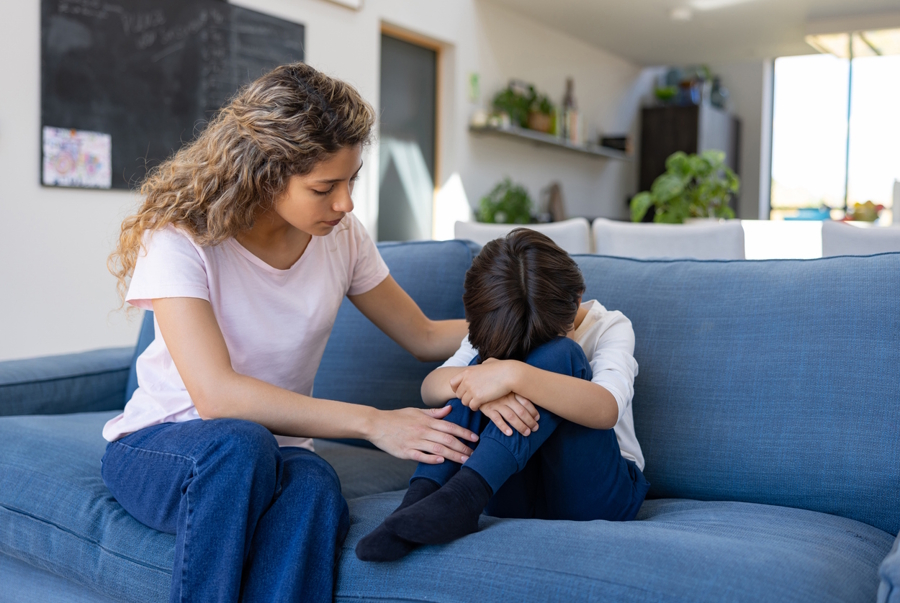
Photo:
iStock
Hand-wringing has become the norm. Mental health problems are surfacing among the most wholesome and advantaged families. “IRL” face time among family members is close to nil compared to online connection. You’d have to be living under a rock not to be concerned about the negative effects on children of social media, governmental policies and extremism on the rise.
Here are some recent questions I’ve heard from parents: “How can I impose expectations for chores, homework and following rules when my kids are already totally stressed out?”; “What can I do if they refuse to go to school after watching news about school shootings?”; and “Isn’t it useless to try to control my teen’s social media consumption?”
For these dilemmas and many others, I recommend a tool called the “both/and.” What the heck is that? Put simply, it means that you both validate your child’s feelings (and your own!) and express your wise-minded perspective or parental decision.
This both/and tool is the essence of the evidence-based research on dialectical behavioral therapy (DBT). Furthermore, validation of feelings and wise parental action are also the basic building blocks of the most tried-and-true parenting programs.
The complexity of how to validate complicated feelings deriving from depressive, anxious and angry emotions, not to mention how to decide a wise action, gives parents pause. That’s the point! With difficult dilemmas, we should pause, get to a sense of calm, deliberate and then express our wise response to child challenges. The goal is to avoid reacting, and instead choose a wise response.
My “CALM” protocol helps guide this decision-making process:
Cool down: Do not respond under the influence of your emotional triggers; breathe deeply so you can think clearly.
Assess your options: Evaluate the pros, cons and risks of several possible approaches so that you can choose an optimal response.
Listen with empathy: Start by validating feelings, which does not mean agreement or approval; it means their feelings make sense from an emotionally attuned perspective.
Make a wise-minded decision: Integrate your cognitive and emotional skills while also using your intuition, so you can decide on an optimal response to the issue at hand. What is a realistic goal? What authoritative policy needs to be employed? What is in the child’s best interest right now?
Here are some examples of child dilemmas and their parents’ both/and responses:
An 8-year-old girl hits her 5-year-old brother because he took her tablet.
“Your anger is completely understandable. I don’t like when people use my belongings without asking permission either. No one does! And it’s super hard to stop the urge to get him back immediately. I appreciate everything you do to stop and use your words instead.
“And since you broke the no-hitting rule and he broke the no-stealing rule, you will both be spending some time in your rooms to calm down right now. I accept that you may think my decision is unfair.”
A 14-year-old who has been struggling with her school performance has a meltdown about her outstanding school assignments. During her emotional flooding and weeping, she says she can’t possibly do anything but chill out with her phone.
“It is a terrible feeling when the mountain just seems too high to climb. You look at those eight math assignments and you just want to hide. You are exhausted from your long day at school. You don’t know where to start with the burden of doing more work. That totally makes sense!
“And after you chill for a while, I’m going to bring you your favorite steamed milk with vanilla. I’m going to sit with you and do my email, while you take a crack at one assignment. We’ll figure this out together because I know how upset you are.”
An 11-year-old, who has always been sensitive and shown anxious tendencies, refuses to go to school after watching news coverage of school shootings online.
“Watching that footage is absolutely traumatizing. History shows us that humans have always been capable of horrible behavior. They are capable of generous and loving behavior also, but the sight of watching violent actions messes with our brains. Scary news footage tricks us into thinking that going to school is more dangerous than it is. It is awful.
“And yet we know that school is still one of the safest places kids can be, so we will make sure you go. We are going to face this challenge together. I know you can have a good day at school.”
A 15-year-old desperately wants to be in his room with the door closed every minute that he is at home, even begrudging dinnertime. He makes adequate grades and acquiesces to the family expectation that he participates in after-school activities, but is snarly about anything that interferes with his gaming.
“I understand that at your age, being with your family is not nearly as appealing as gaming. In your gaming world, you get to interact with friends, experience the exhilaration of your skill and become ecstatic when you achieve new levels of mastery! Even when you fail, you get the challenge of learning from it, trying again and often reaching new heights of competence. I get it that being with us at dinner or on family nights is a dull alternative.
“And we are going to continue to ask that you make an effort to engage positively with us and other activities. It is important to converse, show interest in others and engage in activities that may be less rewarding than the online world. We want you to try harder. I know we are asking a lot of you.”

An 11-year-old wants to put on makeup, wear sexually revealing clothes and mimic teenage influencers. She accuses her parents of being bad parents who hate her sense of fashion.
“I understand that you get a huge kick out of dressing up like a teenager. I know you think I’m old-fashioned and strict because I disallow wearing makeup or some of your outfits outside of the house. Your creativity is a big part of who you are. Your fashion posts are some of your proudest achievements. I love that part of you and want to support your creativity. I really do.
“And I insist that you can explore your fashion sense without it being sexually provocative. We will hold that line while encouraging you to pursue your artistic skills. We trust that there is plenty of room for you to be an artist and a fashionista even while tolerating your parents’ limits. I understand that you are angry about our rules.”
Notice these important features in the parental responses:
- The parents offered multiple validations before they expressed their decision or policy.
- The parents’ acceptance of their child’s feelings was more emphasized than their bottom-line decision.
- The parents were not judgmental about the child’s behavior, habit or outburst.
- The parents did not lecture about how they were right about their determination and their kids were wrong.
- The parents did not expect their children to agree; in fact, they expected that their children may continue to emote or protest.
- The parents showed an understanding that children have their own psychological drives and interests. The parents did not expect to get rid of their children’s negative emotions. When the parents shifted from validating their children’s feelings to expressing their own decisions, they began with “and.” Shifting to their decision with a “but” would nullify or erase their validation.
- The parents demonstrated that they can both empathize with their children’s feelings and impose a decision that will be challenging or difficult for their children to accept.
The both/and tool is a distinctive approach for addressing a dilemma. When triggered by upsetting child behaviors, parents often react with an “either/or” reaction, which implies that one party is wrong and the other is right. Two positions can be valid at the same time!
It is common for parents to default to a “Yes, but” reaction, such as “Yes, you have strong feelings, but my bottom line is more important.” To repeat an important point: If you follow a validation with a “but” phrase emphasizing your decision, you have erased the effective impact of your empathic statements.
Even though the both/and response has a more positive impact than one in which a parent reacts to a child problem emotionally or judgmentally, it is logical to tell a child …
- … that having her tablet taken by a younger sibling is wrong, but hitting is unacceptable and she should be mature enough not to hit a younger sibling.
- … that despite being stressed out, she needs to be responsible for completing her schoolwork.
- … that although school shootings are frightening, he and other students must deal with this fear and manage to go to school anyway.
- … who is isolating in his room that he has a gaming addiction.
- … that seeking attention by being sexually provocative is not the best way to develop self-esteem, nor is it consistent with parental values.
All these statements are true and accurate. However, it’s good to reflect before leading with these reactions by asking yourself: “You might be right, but are you effective?”
Would the child be more likely to cooperate with the “both/and” or the “Yes, but”? Which approach would engender more connection with your child? Even if the child hates their parent’s ultimate position, which approach would be better tolerated by the child?
It’s tempting to focus on how your position is reasonable and correct, but it doesn’t usually result in compliance or agreement. In what silly movie can you imagine an upset and frustrated kid responding to the “Yes, but” approach with “Thanks for your insights! I’m wrong, and you are right!” Still, when we are triggered and engaged in conflict, we all seem to drone on with how our position is reasonable, hoping that the other party will cave and admit that we are right. This is especially true in our families!
Children won’t love the “both/and” approach either, since they are not getting what they want. The goal is that they will feel heard and respected. They may even cooperate with your plan or policy. They are certainly less likely to pitch a huge fit.
Children who feel love in action through connection and understanding will be more cooperative and responsive to their parents’ efforts to guide them.
There is a vast base of research that supports DBT and the positive parenting programs that emphasize empathy and authoritative decision making. Intuitively, it makes sense to most parents that the children who feel love in action through connection and understanding will be more cooperative and responsive to their parents’ efforts to guide them.
The challenge is pulling off the both/and approach in the midst of a highly distressing situation. When our buttons are pushed, our brains tell us “Don’t just stand there. Do something! Put your foot down — now!” Our adrenaline surges and we think, “We can’t let them get away with that!”
And yet, with a little (or a lot of) reflection, we can figure out that lowering the boom will incite more conflict, if not out-and-out rebellion. The CALM protocol gives us a much better chance to figure out how to use the both/and tool for navigating difficult dilemmas. However, it takes a lot of practice and support.
I really believe using the CALM and both/and approaches requires as much practice as the emergency procedures followed by firefighters, police officers and physicians in stressful situations. Maybe more! After all, they aren’t dealing with family members!
Calming ourselves is the ultimate superpower. Any parent knows we respond optimally when we are rested, have time to reflect and feel supported in our valiant efforts to be empathic to ourselves and others.
I know practicing these skills is aspirational, given the number of worries parents are burdened with, but I’m banking on the motivational force of parental love. Love in action is hard to beat, because the both/and approach validates both the child’s feelings and the parent’s need to follow through on authoritative policies.
I am as inspired and moved as ever, witnessing the hard work of parents devoted to the mission of developing both their children’s security and their prosocial behaviors. I wish Nobel Prizes could be given out to ordinary parents doing this work. My intense desire for this Nobel mission is valid — and I’ll settle for this article in the meantime.
Editor’s note: This article was first published in 2023 and was most recently updated with a fact-check by ParentMap’s associate editor, Kari Hanson.











